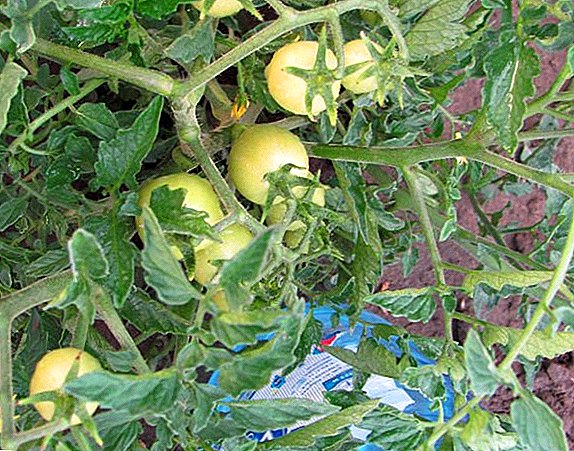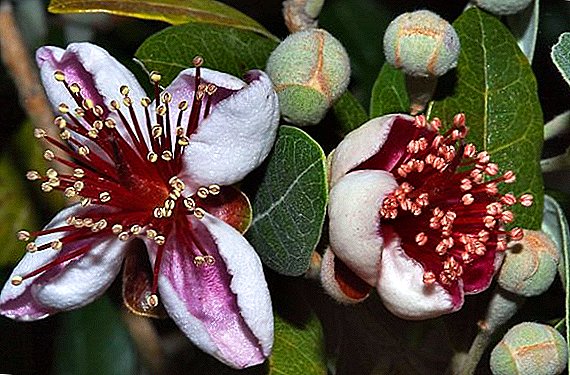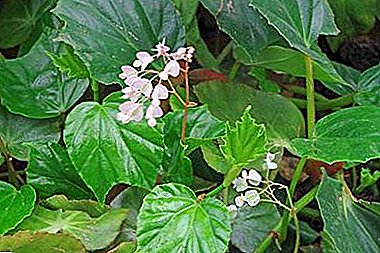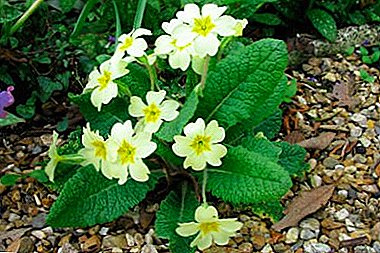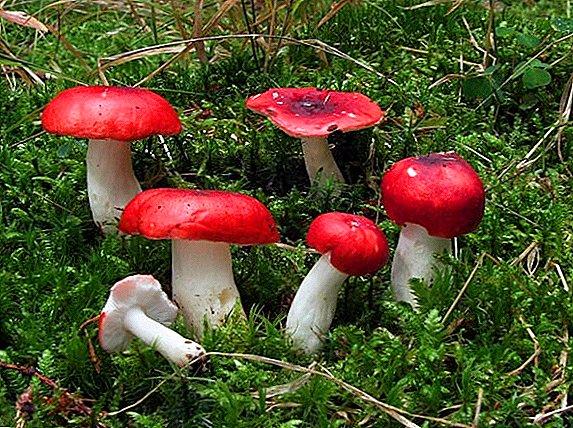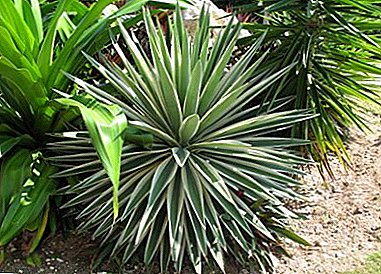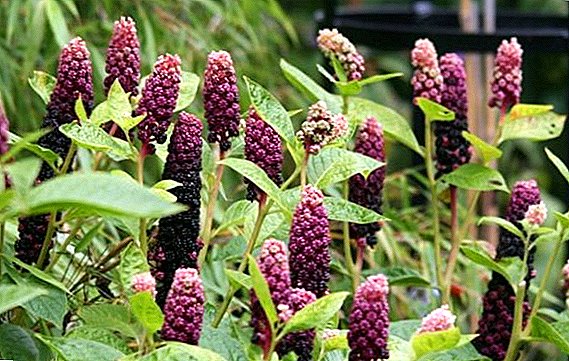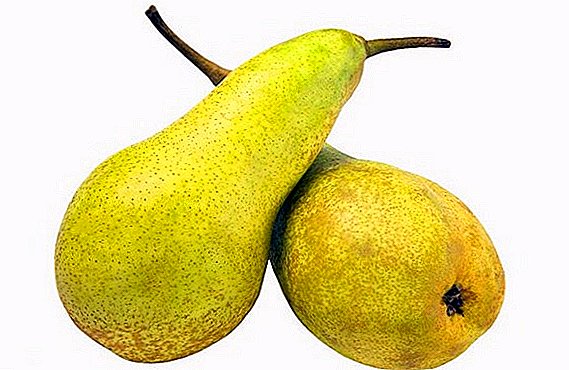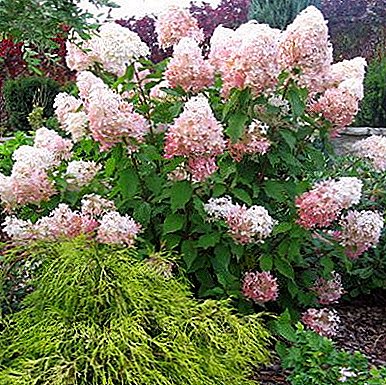
Amateur gardeners often plant hydrangea bushes on their plots - one of the most popular plants for landscape design. Very often the choice falls on hydrangea paniculata grandiflora, which produces large pyramidal inflorescences. Also this bush possesses frost resistance that allows not to carry out its wrapping in the fall.
Description and features of the grandiflora variety

Hortensia paniculata grandiflora can be grown on a site like a bush or a small tree. Its height and crown diameter reach 2-3 meters. Leaves appear in spring much later than other hydrangeas. The main difference of this variety from other types of panicle hydrangea is the size of the inflorescences. They are large, pyramidal in shape, can reach lengths in 30 centimeters. The active flowering period is from July to September. The flowers themselves are sterile in the plant - the fruits cannot form from them. At the beginning of flowering, they have a soft cream color, which gradually becomes bright white, and at the end of the process turns into pink.
The main advantages of hydrangea paniculata grandiflora:
- Lush flowering with large buds;
- Frost resistance;
- High growth rate;
- Plant lasts up to 40 years;
- Resistance to diseases and pests.
Planting and care of hydrangea grandiflora
- the choice of a place for landing
Hydrangea grandiflora is a light-loving plant - it needs the best growth constant stray light. You can also plant in the penumbra, but in no case be placed in open space without protection from direct rays - this sharply slows growth, and inflorescences shrink or flowering stops completely. She also does not like the wind.
IMPORTANT! Experienced gardeners recommend placing a bush near a wall or fence - in the hot afternoon they will create a shade, and in the wind they will cover the plant.
Hydrangea does not react to the pollution of air, so it can be planted as a hedge in the city along the road.
- ground
The plant needs soil with high acidity to pH 6.5 - in neutral soil it does not grow properly, in alkaline may die. You can plant in a clay place, but the bush does not tolerate soil containing lime, wood ash, chalk. The optimal composition of the soil: 2 parts of sod land and peat, and 1 part of sand and humus. You can add pine needles. It is desirable that the soil was fertile - in the period of flowering of the hydrangea paniculata grandiflora actively consumes nutrients.
- watering
Hydrangea is moisture-loving, and for best growth and flowering, it is recommended to water it once a week for 1.5-2 buckets for each bush. But nothing terrible will happen, if you don’t water or rarely do it - the plant will survive the drought, but it will reduce the quantity and quality of the inflorescences. When rains fall, the frequency of watering can be reduced.
- fertilizer / dressing
Hortensia paniculata grandiflora demanding soil nutrition. During flowering, it needs minerals, so it is recommended to additionally feed it.
Fertilizers are applied throughout the year. several stages:
- Organic fertilizers are used in the spring (fermented slurry). However, it is important to make the optimal amount here, otherwise the large inflorescences will grow even more and will break the branches with their weight.
- When the buds appear, a mixture of superphosphate and potassium sulfate (35 grams each) and urea (25 grams) per square meter is applied. soil.
- To extend the flowering is used mineral fertilizer at the rate of 25-30 grams for every 10 liters of water.
Reproduction Methods for Grandiflora Paniculata Hydrangea
Propagation of hydrangea grandiflora can be done with cuttings, branches or division of the bush.
Cuttings obtained by trimming the top of the branches in early July - cut at another time rarely take root. Each should have 5-6 sheets. The two lower ones are cut, and after that, the cutting is put in at 2 knots in loose earth and covered with a can from above. Rooting should be done in the shade, in wet ground conditions.
Dividing bush produce in the spring, before flowering, or in the fall after its completion. The plant is dug out of the ground, and neatly divided into 2-3 parts. It is imperative that on each of them be 2-3 kidneys recovery. After that, each part is planted in its own hole, at the bottom of which organic and mineral fertilizers can be placed in advance.
Breeding by tap - the way is long. To do this, on one branch it is necessary to cut the leaves from the end, to clear a small part of the bark, and with this end to dig into the ground to a depth of 15 centimeters.
The branch is best to fix in this position with wire. Place dripping regularly watered to the formation of its own root system. After that, the branch is cut off from the main plant, and after a while the young bush is transplanted to a new place.
Pruning
Hortensia tolerates pruning, in addition, the process stimulates the active formation of new branches and inflorescences. For accelerated growth, it is carried out sparing, for 2-3 buds. If you want to achieve lush flowering, then all old shoots are removed at the root.
IMPORTANT! In the fall, you should constantly trim off the flowering inflorescences - they pull out a part of the incoming nutrients and reduce the flowering period.
Wintering
Hortensia paniculata grandiflora is frost resistant plant, and therefore when grown in the middle and southern parts of Russia, shelter is not required. However, if the winters are cold and dry, then you can cover the soil around the bush to protect the roots from freezing with a layer of humus. Young plants are protected by wrapping them in several layers of burlap, or by creating "coat" of dried leaves. With age, the hardiness of hydrangea grandiflora only increases.
Diseases and pests

The main problems faced by the owners of hydrangea grandiflora - the appearance of powdery mildew and the attack of garden aphids.
To combat powdery mildew, the bush must be sprayed with special preparations before flowering. Ohikom, Fundazol and similar, following the instructions for use.
Aphids can be driven by processing chemicals, or independently prepare a solution of infused garlic (250 g) with the addition of laundry soap (50 g).
Spraying should be carried out weekly.
Grandiflora is one of the types of paniculate hydrangeas. She inherited frost resistance, and has large inflorescences in the form of pyramids. The plant is unpretentious in care and can spend the winter on the street - it is recommended to shelter only young fragile plants.
A photo
Photo hydrangea grandiflora see below:




Useful information
You can get acquainted with other materials about hydrangea garden:
- How to properly care for bobo paniculate hydrangea? Growing and preparing for winter
- How to properly care for Hydrangea Limelight?
- How does the Duboliferous hydrangea overwinter?
- Frost-resistant hydrangea Pinky Winky on your site
- Hydrangea curly (petiolate, climbing) - a hedge in your garden!
- Hydrangea tree Annabelle - snow-white decoration of your site
- Tree hydrangea in your garden - planting and care, breeding, wintering
- How to make friends with serrated hydrangea?
- Japanese hydrangea Kyushu in your garden
- Frost-resistant large-leaved hydrangea
- How to care for a panicle hydrangea phantom? Planting, wintering, breeding
- How to properly care for panilla hydrangea vanilla fraze?
- Fragrant "princess" hydrangea paniculata in your garden: features of care
- Secrets of breeding garden hydrangea
- Garden hydrangea: planting and care, neighborhood in the garden
- Do not let the garden hydrangea freeze! How to cover the hydrangea for the winter?
- How to protect the garden hydrangea from diseases and pests?


